Một số chỉ tiêu nhân trắc và tình trạng dinh dưỡng của học sinh từ 6 - 10 tuổi thuộc khu vực miền núi tỉnh Bình Định
Mục tiêu của bài báo là đánh giá một số chỉ tiêu nhân trắc, từ đó thấy được tình trạng dinh dưỡng của học
sinh từ 6 - 10 tuổi thuộc khu vực miền núi. Nghiên cứu được tiến hành trên 2.040 học sinh (gồm 1.024 nam và
1.016 nữ) thuộc một số huyện miền núi tỉnh Bình Định theo phương pháp mô tả cắt ngang có so sánh. Kết quả
nghiên cứu cho thấy, các chỉ tiêu nhân trắc cơ bản: chiều cao, cân nặng, vòng ngực, vòng đầu của học sinh khu vực
miền núi tỉnh Bình Định tăng dần theo tuổi và hầu hết các chỉ số đều thấp hơn so với học sinh cùng độ tuổi ở các
khu vực khác trong nước và trên thế giới. Học sinh miền núi tỉnh Bình Định có tỷ lệ suy dinh dưỡng là 21,67%,
tỷ lệ này là khá cao so với cả nước và trong khu vực, vì vậy cần có những kế hoạch đầu tư hơn nữa về mọi mặt
cho các khu vực miền núi, nhằm giúp sự tăng trưởng của học sinh tốt hơn, góp phần nâng cao tầm vóc người Việt
Nam trên cả nước.

Trang 1
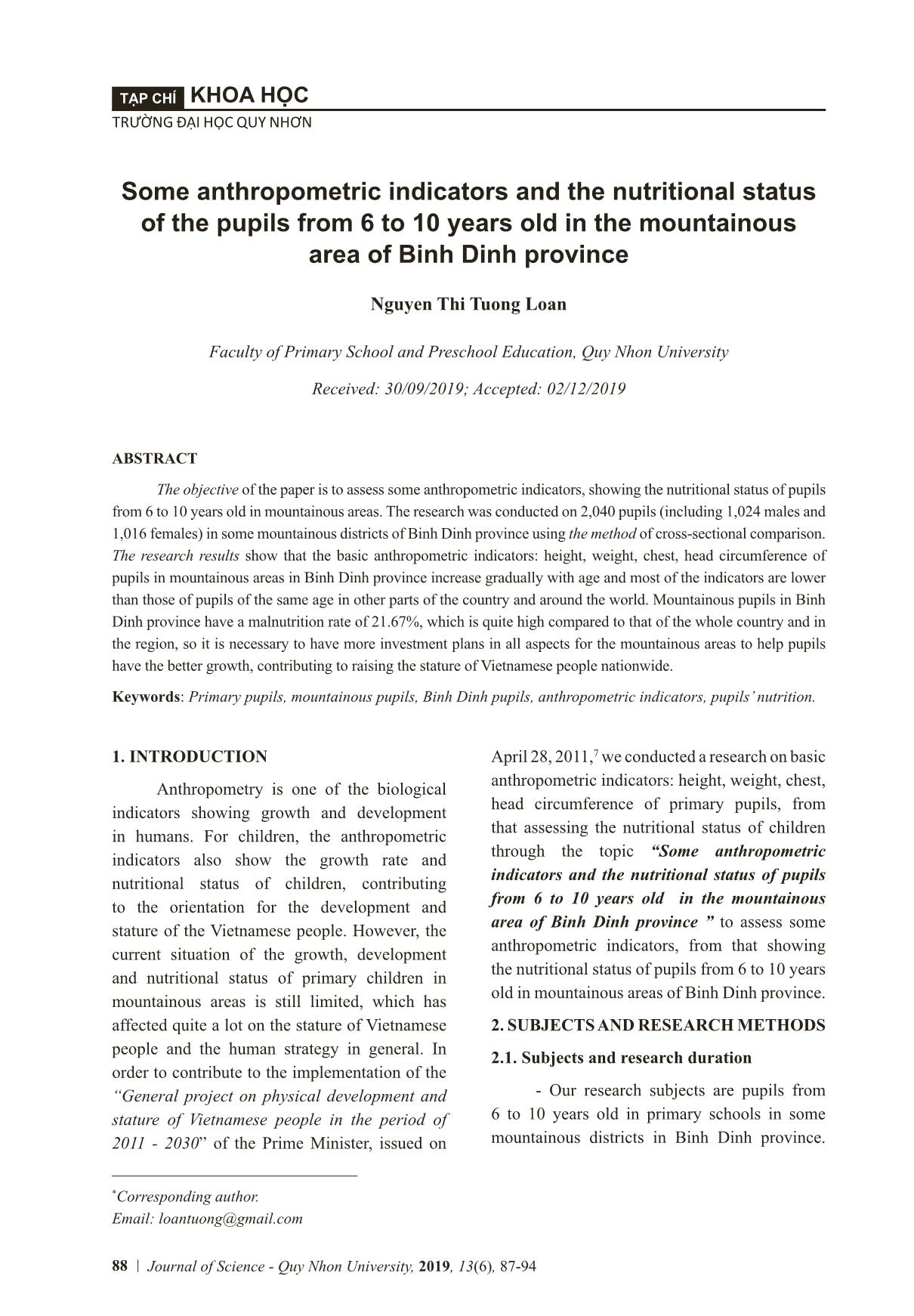
Trang 2
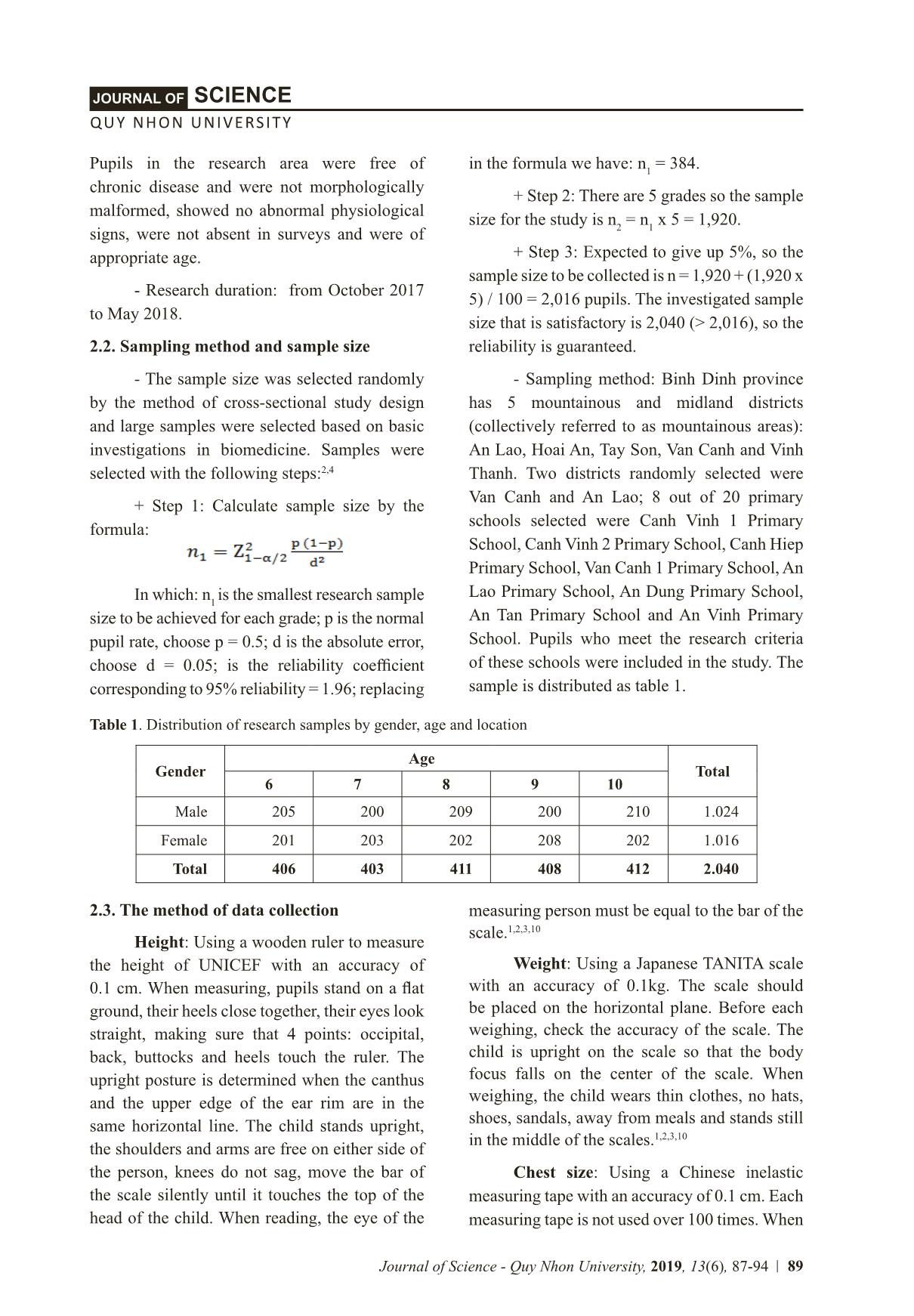
Trang 3
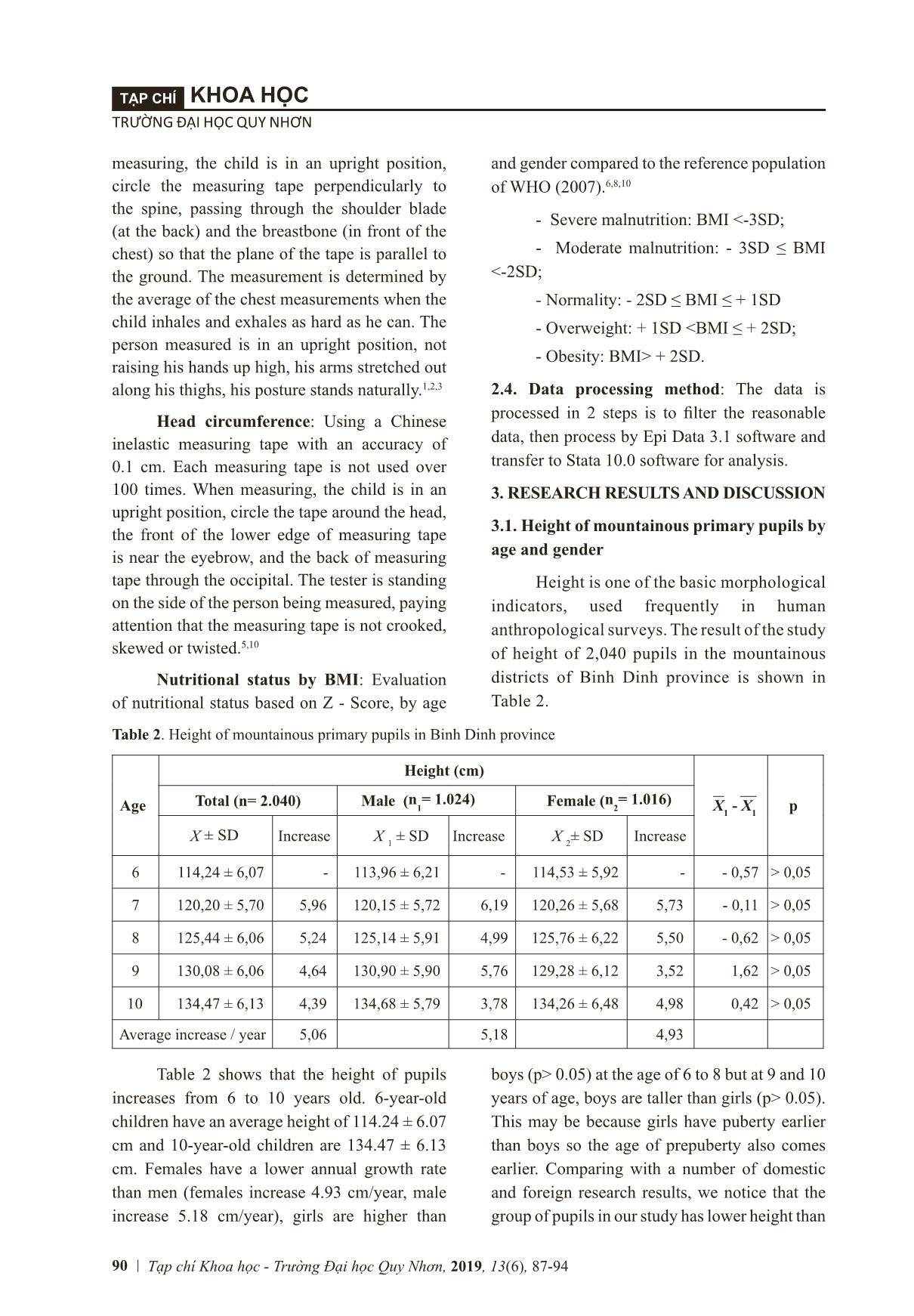
Trang 4
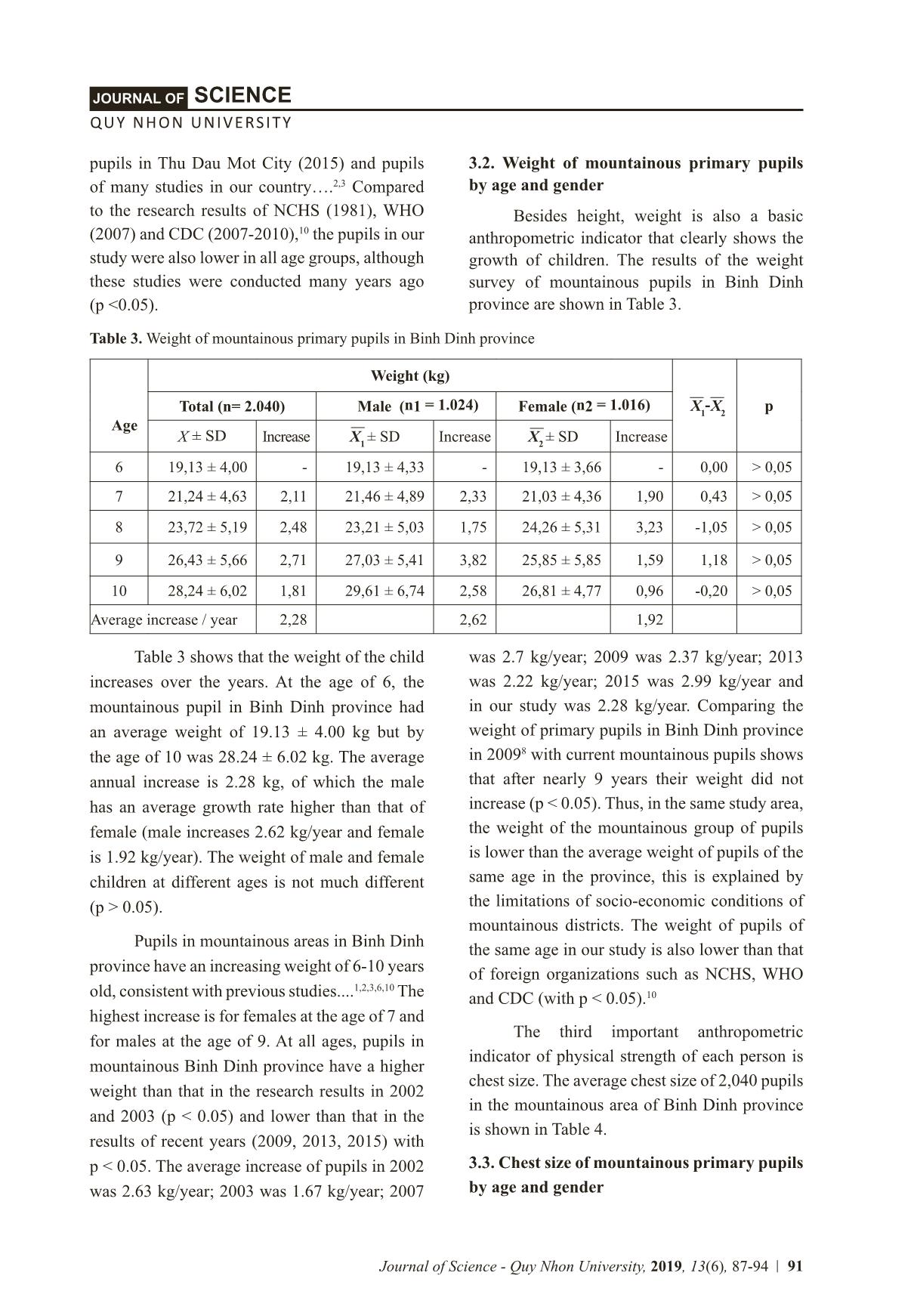
Trang 5
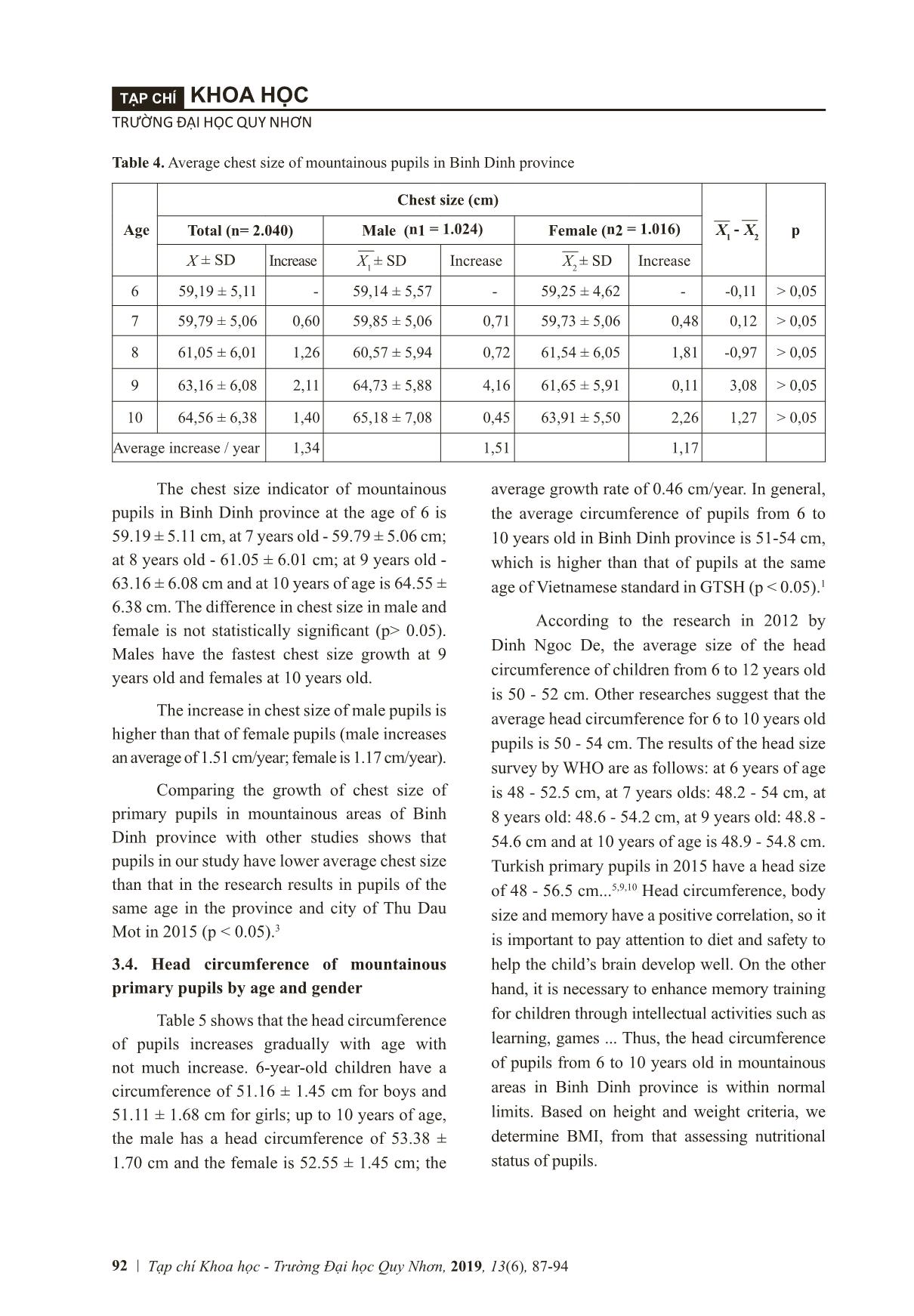
Trang 6
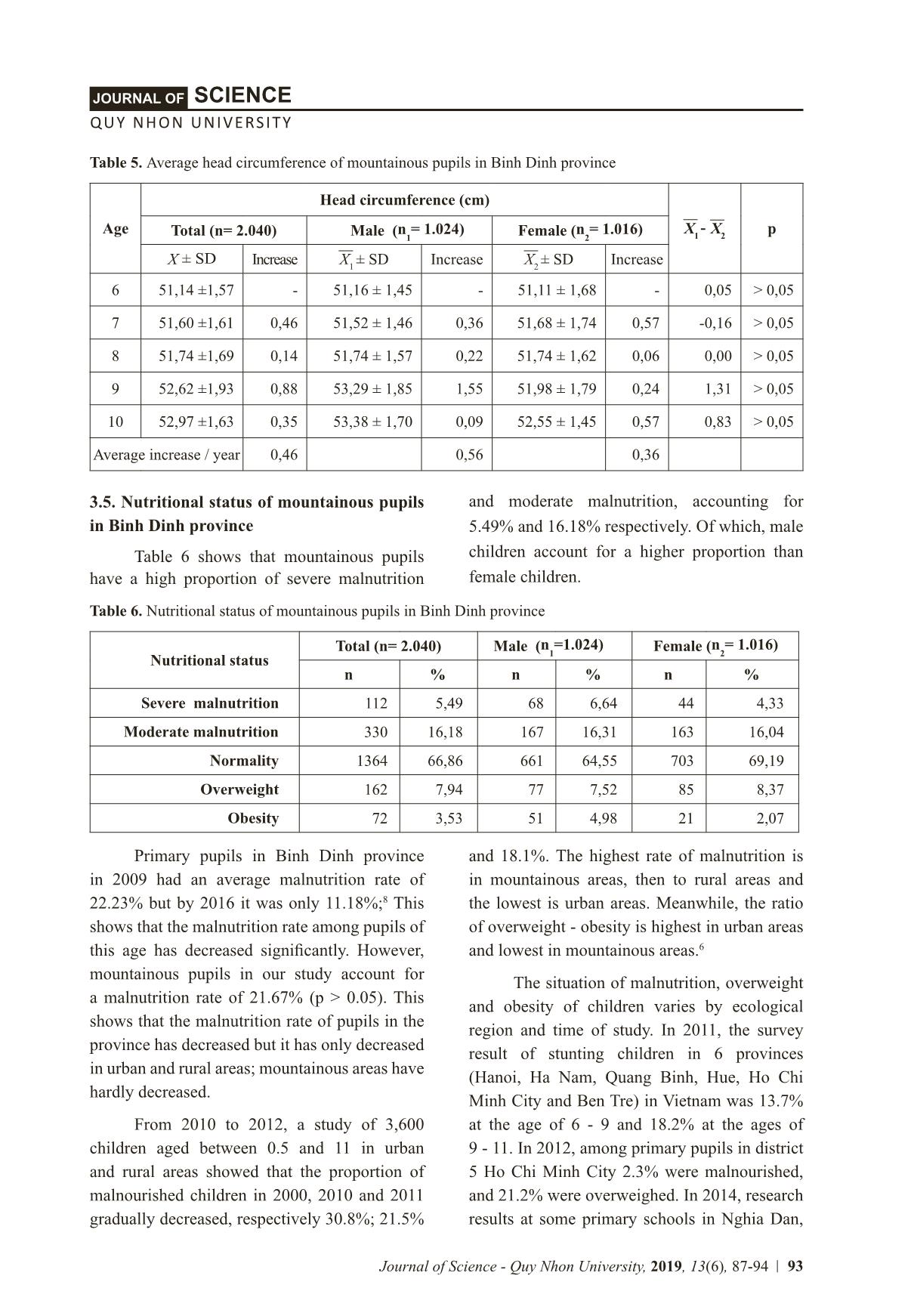
Trang 7
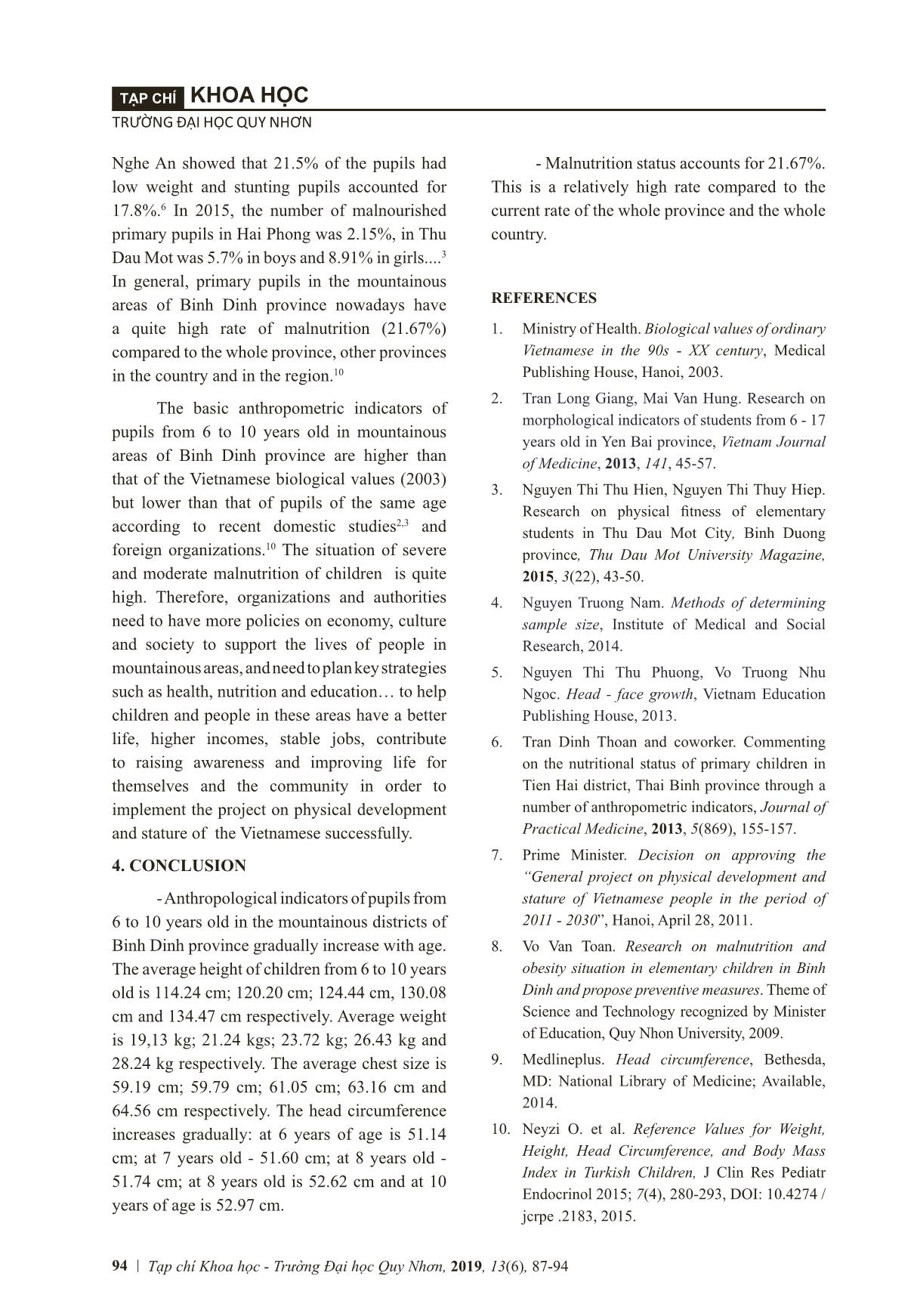
Trang 8
Tóm tắt nội dung tài liệu: Một số chỉ tiêu nhân trắc và tình trạng dinh dưỡng của học sinh từ 6 - 10 tuổi thuộc khu vực miền núi tỉnh Bình Định
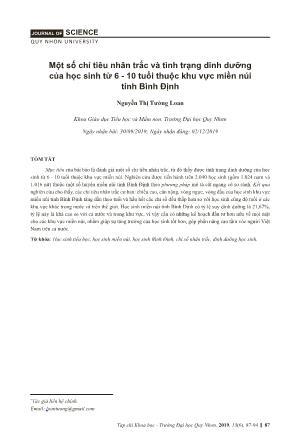
87 QUY NHON UNIVERSITY SCIENCEJOURNAL OF Tạp chí Khoa học - Trường Đại học Quy Nhơn, 2019, 13(6), 87-94 Một số chỉ tiêu nhân trắc và tình trạng dinh dưỡng của học sinh từ 6 - 10 tuổi thuộc khu vực miền núi tỉnh Bình Định Nguyễn Thị Tường Loan Khoa Giáo dục Tiểu học và Mầm non, Trường Đại học Quy Nhơn Ngày nhận bài: 30/09/2019; Ngày nhận đăng: 02/12/2019 TÓM TẮT Mục tiêu của bài báo là đánh giá một số chỉ tiêu nhân trắc, từ đó thấy được tình trạng dinh dưỡng của học sinh từ 6 - 10 tuổi thuộc khu vực miền núi. Nghiên cứu được tiến hành trên 2.040 học sinh (gồm 1.024 nam và 1.016 nữ) thuộc một số huyện miền núi tỉnh Bình Định theo phương pháp mô tả cắt ngang có so sánh. Kết quả nghiên cứu cho thấy, các chỉ tiêu nhân trắc cơ bản: chiều cao, cân nặng, vòng ngực, vòng đầu của học sinh khu vực miền núi tỉnh Bình Định tăng dần theo tuổi và hầu hết các chỉ số đều thấp hơn so với học sinh cùng độ tuổi ở các khu vực khác trong nước và trên thế giới. Học sinh miền núi tỉnh Bình Định có tỷ lệ suy dinh dưỡng là 21,67%, tỷ lệ này là khá cao so với cả nước và trong khu vực, vì vậy cần có những kế hoạch đầu tư hơn nữa về mọi mặt cho các khu vực miền núi, nhằm giúp sự tăng trưởng của học sinh tốt hơn, góp phần nâng cao tầm vóc người Việt Nam trên cả nước. Từ khóa: Học sinh tiểu học, học sinh miền núi, học sinh Bình Định, chỉ số nhân trắc, dinh dưỡng học sinh. *Tác giả liên hệ chính. Email: loantuong@gmail.com 88 TRƯỜNG ĐẠI HỌC QUY NHƠN KHOA HỌCTẠP CHÍ Journal of Science - Quy Nhon University, 2019, 13(6), 87-94 Some anthropometric indicators and the nutritional status of the pupils from 6 to 10 years old in the mountainous area of Binh Dinh province Nguyen Thi Tuong Loan Faculty of Primary School and Preschool Education, Quy Nhon University Received: 30/09/2019; Accepted: 02/12/2019 ABSTRACT The objective of the paper is to assess some anthropometric indicators, showing the nutritional status of pupils from 6 to 10 years old in mountainous areas. The research was conducted on 2,040 pupils (including 1,024 males and 1,016 females) in some mountainous districts of Binh Dinh province using the method of cross-sectional comparison. The research results show that the basic anthropometric indicators: height, weight, chest, head circumference of pupils in mountainous areas in Binh Dinh province increase gradually with age and most of the indicators are lower than those of pupils of the same age in other parts of the country and around the world. Mountainous pupils in Binh Dinh province have a malnutrition rate of 21.67%, which is quite high compared to that of the whole country and in the region, so it is necessary to have more investment plans in all aspects for the mountainous areas to help pupils have the better growth, contributing to raising the stature of Vietnamese people nationwide. Keywords: Primary pupils, mountainous pupils, Binh Dinh pupils, anthropometric indicators, pupils’ nutrition. *Corresponding author. Email: loantuong@gmail.com 1. INTRODUCTION Anthropometry is one of the biological indicators showing growth and development in humans. For children, the anthropometric indicators also show the growth rate and nutritional status of children, contributing to the orientation for the development and stature of the Vietnamese people. However, the current situation of the growth, development and nutritional status of primary children in mountainous areas is still limited, which has affected quite a lot on the stature of Vietnamese people and the human strategy in general. In order to contribute to the implementation of the “General project on physical development and stature of Vietnamese people in the period of 2011 - 2030” of the Prime Minister, issued on April 28, 2011,7 we conducted a research on basic anthropometric indicators: height, weight, chest, head circumference of primary pupils, from that assessing the nutritional status of children through the topic “Some anthropometric indicators and the nutritional status of pupils from 6 to 10 years old in the mountainous area of Binh Dinh province ” to assess some anthropometric indicators, from that showing the nutritional status of pupils from 6 to 10 years old in mountainous areas of Binh Dinh province. 2. SUBJECTS AND RESEARCH METHODS 2.1. Subjects and research duration - Our research subjects are pupils from 6 to 10 years old in primary schools in some mountainous districts in Binh Dinh province. 89 QUY NHON UNIVERSITY SCIENCEJOURNAL OF Journal of Science - Quy Nhon University, 2019, 13(6), 87-94 Pupils in the research area were free of chronic disease and were not morphologically malformed, showed no abnormal physiological signs, were not absent in surveys and were of appropriate age. - Research duration: from October 2017 to May 2018. 2.2. Sampling method and sample size - The sample size was selected randomly by ... primary pupils in Binh Dinh province Age Height (cm) X1 - X1 pTotal (n= 2.040) Male ( n 1 = 1.024) Female (n2= 1.016) X ± SD Increase X 1 ± SD Increase X 2± SD Increase 6 114,24 ± 6,07 - 113,96 ± 6,21 - 114,53 ± 5,92 - - 0,57 > 0,05 7 120,20 ± 5,70 5,96 120,15 ± 5,72 6,19 120,26 ± 5,68 5,73 - 0,11 > 0,05 8 125,44 ± 6,06 5,24 125,14 ± 5,91 4,99 125,76 ± 6,22 5,50 - 0,62 > 0,05 9 130,08 ± 6,06 4,64 130,90 ± 5,90 5,76 129,28 ± 6,12 3,52 1,62 > 0,05 10 134,47 ± 6,13 4,39 134,68 ± 5,79 3,78 134,26 ± 6,48 4,98 0,42 > 0,05 Average increase / year 5,06 5,18 4,93 Table 2 shows that the height of pupils increases from 6 to 10 years old. 6-year-old children have an average height of 114.24 ± 6.07 cm and 10-year-old children are 134.47 ± 6.13 cm. Females have a lower annual growth rate than men (females increase 4.93 cm/year, male increase 5.18 cm/year), girls are higher than boys (p> 0.05) at the age of 6 to 8 but at 9 and 10 years of age, boys are taller than girls (p> 0.05). This may be because girls have puberty earlier than boys so the age of prepuberty also comes earlier. Comparing with a number of domestic and foreign research results, we notice that the group of pupils in our study has lower height than 91 QUY NHON UNIVERSITY SCIENCEJOURNAL OF Journal of Science - Quy Nhon University, 2019, 13(6), 87-94 pupils in Thu Dau Mot City (2015) and pupils of many studies in our country.2,3 Compared to the research results of NCHS (1981), WHO (2007) and CDC (2007-2010),10 the pupils in our study were also lower in all age groups, although these studies were conducted many years ago (p <0.05). 3.2. Weight of mountainous primary pupils by age and gender Besides height, weight is also a basic anthropometric indicator that clearly shows the growth of children. The results of the weight survey of mountainous pupils in Binh Dinh province are shown in Table 3. Table 3. Weight of mountainous primary pupils in Binh Dinh province Age Weight (kg) X1-X2 pTotal (n= 2.040) Male (n1 = 1.024) Female (n2 = 1.016) X ± SD Increase X1 ± SD Increase X2 ± SD Increase 6 19,13 ± 4,00 - 19,13 ± 4,33 - 19,13 ± 3,66 - 0,00 > 0,05 7 21,24 ± 4,63 2,11 21,46 ± 4,89 2,33 21,03 ± 4,36 1,90 0,43 > 0,05 8 23,72 ± 5,19 2,48 23,21 ± 5,03 1,75 24,26 ± 5,31 3,23 -1,05 > 0,05 9 26,43 ± 5,66 2,71 27,03 ± 5,41 3,82 25,85 ± 5,85 1,59 1,18 > 0,05 10 28,24 ± 6,02 1,81 29,61 ± 6,74 2,58 26,81 ± 4,77 0,96 -0,20 > 0,05 Average increase / year 2,28 2,62 1,92 Table 3 shows that the weight of the child increases over the years. At the age of 6, the mountainous pupil in Binh Dinh province had an average weight of 19.13 ± 4.00 kg but by the age of 10 was 28.24 ± 6.02 kg. The average annual increase is 2.28 kg, of which the male has an average growth rate higher than that of female (male increases 2.62 kg/year and female is 1.92 kg/year). The weight of male and female children at different ages is not much different (p > 0.05). Pupils in mountainous areas in Binh Dinh province have an increasing weight of 6-10 years old, consistent with previous studies....1,2,3,6,10 The highest increase is for females at the age of 7 and for males at the age of 9. At all ages, pupils in mountainous Binh Dinh province have a higher weight than that in the research results in 2002 and 2003 (p < 0.05) and lower than that in the results of recent years (2009, 2013, 2015) with p < 0.05. The average increase of pupils in 2002 was 2.63 kg/year; 2003 was 1.67 kg/year; 2007 was 2.7 kg/year; 2009 was 2.37 kg/year; 2013 was 2.22 kg/year; 2015 was 2.99 kg/year and in our study was 2.28 kg/year. Comparing the weight of primary pupils in Binh Dinh province in 20098 with current mountainous pupils shows that after nearly 9 years their weight did not increase (p < 0.05). Thus, in the same study area, the weight of the mountainous group of pupils is lower than the average weight of pupils of the same age in the province, this is explained by the limitations of socio-economic conditions of mountainous districts. The weight of pupils of the same age in our study is also lower than that of foreign organizations such as NCHS, WHO and CDC (with p < 0.05).10 The third important anthropometric indicator of physical strength of each person is chest size. The average chest size of 2,040 pupils in the mountainous area of Binh Dinh province is shown in Table 4. 3.3. Chest size of mountainous primary pupils by age and gender 92 TRƯỜNG ĐẠI HỌC QUY NHƠN KHOA HỌCTẠP CHÍ Tạp chí Khoa học - Trường Đại học Quy Nhơn, 2019, 13(6), 87-94 Table 4. Average chest size of mountainous pupils in Binh Dinh province Age Chest size (cm) X1 - X2 pTotal (n= 2.040) Male (n1 = 1.024) Female (n2 = 1.016) X ± SD Increase X 1 ± SD Increase X 2 ± SD Increase 6 59,19 ± 5,11 - 59,14 ± 5,57 - 59,25 ± 4,62 - -0,11 > 0,05 7 59,79 ± 5,06 0,60 59,85 ± 5,06 0,71 59,73 ± 5,06 0,48 0,12 > 0,05 8 61,05 ± 6,01 1,26 60,57 ± 5,94 0,72 61,54 ± 6,05 1,81 -0,97 > 0,05 9 63,16 ± 6,08 2,11 64,73 ± 5,88 4,16 61,65 ± 5,91 0,11 3,08 > 0,05 10 64,56 ± 6,38 1,40 65,18 ± 7,08 0,45 63,91 ± 5,50 2,26 1,27 > 0,05 Average increase / year 1,34 1,51 1,17 The chest size indicator of mountainous pupils in Binh Dinh province at the age of 6 is 59.19 ± 5.11 cm, at 7 years old - 59.79 ± 5.06 cm; at 8 years old - 61.05 ± 6.01 cm; at 9 years old - 63.16 ± 6.08 cm and at 10 years of age is 64.55 ± 6.38 cm. The difference in chest size in male and female is not statistically significant (p> 0.05). Males have the fastest chest size growth at 9 years old and females at 10 years old. The increase in chest size of male pupils is higher than that of female pupils (male increases an average of 1.51 cm/year; female is 1.17 cm/year). Comparing the growth of chest size of primary pupils in mountainous areas of Binh Dinh province with other studies shows that pupils in our study have lower average chest size than that in the research results in pupils of the same age in the province and city of Thu Dau Mot in 2015 (p < 0.05).3 3.4. Head circumference of mountainous primary pupils by age and gender Table 5 shows that the head circumference of pupils increases gradually with age with not much increase. 6-year-old children have a circumference of 51.16 ± 1.45 cm for boys and 51.11 ± 1.68 cm for girls; up to 10 years of age, the male has a head circumference of 53.38 ± 1.70 cm and the female is 52.55 ± 1.45 cm; the average growth rate of 0.46 cm/year. In general, the average circumference of pupils from 6 to 10 years old in Binh Dinh province is 51-54 cm, which is higher than that of pupils at the same age of Vietnamese standard in GTSH (p < 0.05).1 According to the research in 2012 by Dinh Ngoc De, the average size of the head circumference of children from 6 to 12 years old is 50 - 52 cm. Other researches suggest that the average head circumference for 6 to 10 years old pupils is 50 - 54 cm. The results of the head size survey by WHO are as follows: at 6 years of age is 48 - 52.5 cm, at 7 years olds: 48.2 - 54 cm, at 8 years old: 48.6 - 54.2 cm, at 9 years old: 48.8 - 54.6 cm and at 10 years of age is 48.9 - 54.8 cm. Turkish primary pupils in 2015 have a head size of 48 - 56.5 cm...5,9,10 Head circumference, body size and memory have a positive correlation, so it is important to pay attention to diet and safety to help the child’s brain develop well. On the other hand, it is necessary to enhance memory training for children through intellectual activities such as learning, games ... Thus, the head circumference of pupils from 6 to 10 years old in mountainous areas in Binh Dinh province is within normal limits. Based on height and weight criteria, we determine BMI, from that assessing nutritional status of pupils. 93 QUY NHON UNIVERSITY SCIENCEJOURNAL OF Journal of Science - Quy Nhon University, 2019, 13(6), 87-94 Table 5. Average head circumference of mountainous pupils in Binh Dinh province Age Head circumference (cm) X 1 - X2 pTotal (n= 2.040) Male (n1= 1.024) Female (n2= 1.016) X ± SD Increase X 1 ± SD Increase X 2 ± SD Increase 6 51,14 ±1,57 - 51,16 ± 1,45 - 51,11 ± 1,68 - 0,05 > 0,05 7 51,60 ±1,61 0,46 51,52 ± 1,46 0,36 51,68 ± 1,74 0,57 -0,16 > 0,05 8 51,74 ±1,69 0,14 51,74 ± 1,57 0,22 51,74 ± 1,62 0,06 0,00 > 0,05 9 52,62 ±1,93 0,88 53,29 ± 1,85 1,55 51,98 ± 1,79 0,24 1,31 > 0,05 10 52,97 ±1,63 0,35 53,38 ± 1,70 0,09 52,55 ± 1,45 0,57 0,83 > 0,05 Average increase / year 0,46 0,56 0,36 3.5. Nutritional status of mountainous pupils in Binh Dinh province Table 6 shows that mountainous pupils have a high proportion of severe malnutrition and moderate malnutrition, accounting for 5.49% and 16.18% respectively. Of which, male children account for a higher proportion than female children. Table 6. Nutritional status of mountainous pupils in Binh Dinh province Nutritional status Total (n= 2.040) Male (n1=1.024) Female (n2= 1.016) n % n % n % Severe malnutrition 112 5,49 68 6,64 44 4,33 Moderate malnutrition 330 16,18 167 16,31 163 16,04 Normality 1364 66,86 661 64,55 703 69,19 Overweight 162 7,94 77 7,52 85 8,37 Obesity 72 3,53 51 4,98 21 2,07 Primary pupils in Binh Dinh province in 2009 had an average malnutrition rate of 22.23% but by 2016 it was only 11.18%;8 This shows that the malnutrition rate among pupils of this age has decreased significantly. However, mountainous pupils in our study account for a malnutrition rate of 21.67% (p > 0.05). This shows that the malnutrition rate of pupils in the province has decreased but it has only decreased in urban and rural areas; mountainous areas have hardly decreased. From 2010 to 2012, a study of 3,600 children aged between 0.5 and 11 in urban and rural areas showed that the proportion of malnourished children in 2000, 2010 and 2011 gradually decreased, respectively 30.8%; 21.5% and 18.1%. The highest rate of malnutrition is in mountainous areas, then to rural areas and the lowest is urban areas. Meanwhile, the ratio of overweight - obesity is highest in urban areas and lowest in mountainous areas.6 The situation of malnutrition, overweight and obesity of children varies by ecological region and time of study. In 2011, the survey result of stunting children in 6 provinces (Hanoi, Ha Nam, Quang Binh, Hue, Ho Chi Minh City and Ben Tre) in Vietnam was 13.7% at the age of 6 - 9 and 18.2% at the ages of 9 - 11. In 2012, among primary pupils in district 5 Ho Chi Minh City 2.3% were malnourished, and 21.2% were overweighed. In 2014, research results at some primary schools in Nghia Dan, 94 TRƯỜNG ĐẠI HỌC QUY NHƠN KHOA HỌCTẠP CHÍ Tạp chí Khoa học - Trường Đại học Quy Nhơn, 2019, 13(6), 87-94 Nghe An showed that 21.5% of the pupils had low weight and stunting pupils accounted for 17.8%.6 In 2015, the number of malnourished primary pupils in Hai Phong was 2.15%, in Thu Dau Mot was 5.7% in boys and 8.91% in girls....3 In general, primary pupils in the mountainous areas of Binh Dinh province nowadays have a quite high rate of malnutrition (21.67%) compared to the whole province, other provinces in the country and in the region.10 The basic anthropometric indicators of pupils from 6 to 10 years old in mountainous areas of Binh Dinh province are higher than that of the Vietnamese biological values (2003) but lower than that of pupils of the same age according to recent domestic studies2,3 and foreign organizations.10 The situation of severe and moderate malnutrition of children is quite high. Therefore, organizations and authorities need to have more policies on economy, culture and society to support the lives of people in mountainous areas, and need to plan key strategies such as health, nutrition and education to help children and people in these areas have a better life, higher incomes, stable jobs, contribute to raising awareness and improving life for themselves and the community in order to implement the project on physical development and stature of the Vietnamese successfully. 4. CONCLUSION - Anthropological indicators of pupils from 6 to 10 years old in the mountainous districts of Binh Dinh province gradually increase with age. The average height of children from 6 to 10 years old is 114.24 cm; 120.20 cm; 124.44 cm, 130.08 cm and 134.47 cm respectively. Average weight is 19,13 kg; 21.24 kgs; 23.72 kg; 26.43 kg and 28.24 kg respectively. The average chest size is 59.19 cm; 59.79 cm; 61.05 cm; 63.16 cm and 64.56 cm respectively. The head circumference increases gradually: at 6 years of age is 51.14 cm; at 7 years old - 51.60 cm; at 8 years old - 51.74 cm; at 8 years old is 52.62 cm and at 10 years of age is 52.97 cm. - Malnutrition status accounts for 21.67%. This is a relatively high rate compared to the current rate of the whole province and the whole country. REFERENCES 1. Ministry of Health. Biological values of ordinary Vietnamese in the 90s - XX century, Medical Publishing House, Hanoi, 2003. 2. Tran Long Giang, Mai Van Hung. Research on morphological indicators of students from 6 - 17 years old in Yen Bai province, Vietnam Journal of Medicine, 2013, 141, 45-57. 3. Nguyen Thi Thu Hien, Nguyen Thi Thuy Hiep. Research on physical fitness of elementary students in Thu Dau Mot City, Binh Duong province, Thu Dau Mot University Magazine, 2015, 3(22), 43-50. 4. Nguyen Truong Nam. Methods of determining sample size, Institute of Medical and Social Research, 2014. 5. Nguyen Thi Thu Phuong, Vo Truong Nhu Ngoc. Head - face growth, Vietnam Education Publishing House, 2013. 6. Tran Dinh Thoan and coworker. Commenting on the nutritional status of primary children in Tien Hai district, Thai Binh province through a number of anthropometric indicators, Journal of Practical Medicine, 2013, 5(869), 155-157. 7. Prime Minister. Decision on approving the “General project on physical development and stature of Vietnamese people in the period of 2011 - 2030”, Hanoi, April 28, 2011. 8. Vo Van Toan. Research on malnutrition and obesity situation in elementary children in Binh Dinh and propose preventive measures. Theme of Science and Technology recognized by Minister of Education, Quy Nhon University, 2009. 9. Medlineplus. Head circumference, Bethesda, MD: National Library of Medicine; Available, 2014. 10. Neyzi O. et al. Reference Values for Weight, Height, Head Circumference, and Body Mass Index in Turkish Children, J Clin Res Pediatr Endocrinol 2015; 7(4), 280-293, DOI: 10.4274 / jcrpe .2183, 2015.
File đính kèm:
 mot_so_chi_tieu_nhan_trac_va_tinh_trang_dinh_duong_cua_hoc_s.pdf
mot_so_chi_tieu_nhan_trac_va_tinh_trang_dinh_duong_cua_hoc_s.pdf

